How does our own bias get in the middle of our design decisions?
We are driven by how we are brought up, the way we think, our past and current relationships, our circle of friends, how fast we move, and how anxious we get with little things. These factors influence our style, the way we write, the colors we choose, the way we design products.
But we forget one thing… Our body and mind are constantly evolving towards a state that requires more and more attention.
TL;DR
In this time-travel activity, I propose an activity that focuses on creating an inclusive mindset from the standpoint that a lack of disability is, in fact, only temporary.
Awareness of future disabilities or lifestyle changes could make us more aware of whom we are excluding Today. If UX professionals anticipate that they will lose their current abilities, they will develop more inclusive mindsets.
After this activity, you will:
- learn from past mistakes
- identify any missed opportunities
- recognize how new technologies, techniques, or methodologies could have helped past projects
- consider your own potential future disabilities as you grow older
- account for global events that could impact the way we live
Don Norman’s wisdom
I came across a recent article by Don Norman titled: I wrote the book on user-friendly design. What I see Today horrifies me.
Don Norman is one of the fathers of User Experience, and he wrote a popular book back in the 80s called The Design of Everyday Things.
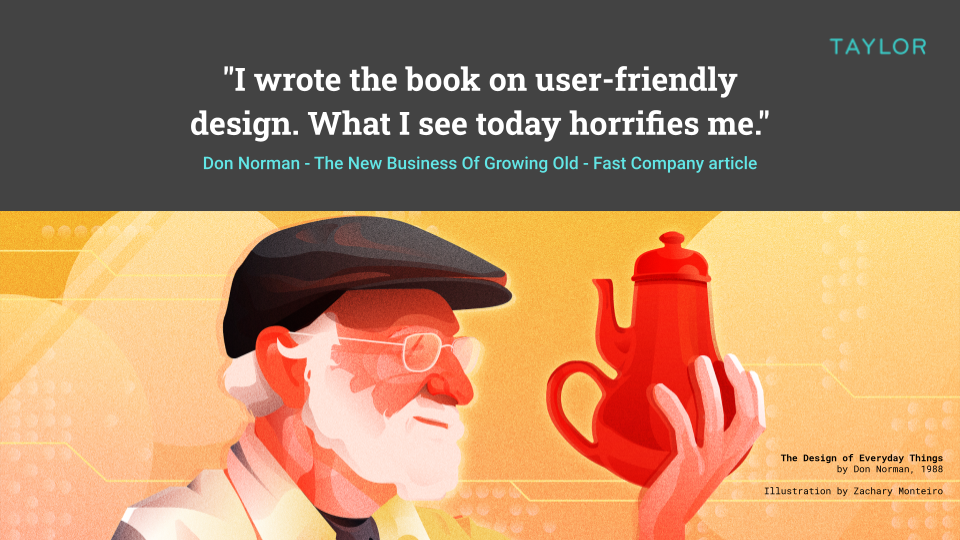
The Design of Everyday Things by Don Norman, 1988. Illustration by Zachary Monteiro
In this recent article, he describes how much he didn’t know about his future when he wrote his famous design book back in 1980:
"Do not think that thoughtful design is just for the elderly, or the sick, or the disabled.
In the field of design, this is called inclusive design for a reason: It helps everyone."
- Donald Norman, 2019
His article made me reflect on how biased we are towards our current conditions, abilities, and mindset when we create solutions for others.
We are a collection of our past, not our future.
We are driven by how we were raised. Whether we were exposed to different beliefs, or how many relationships we had along the way, how many heartbreaks, etc.
Because of our past experiences, we will always make decisions based on how our present-self summons our collective past experiences in whatever profession we may choose.
Interviewing your future self
As a product designer, I constantly think about the end-users and how they will interact with the design solutions I create. But what if I was blind myself? How differently would the solutions I design be?
But what if I was blind myself?
How differently would the solutions I design be?
These question led me to create an inclusive design activity to help the teams developing empathy towards older adults and people with disabilities.
Imagine for a moment that your future self visits you, returning from 30 years in the future, to have a Ask Me Anything (AMA) session with you Today.
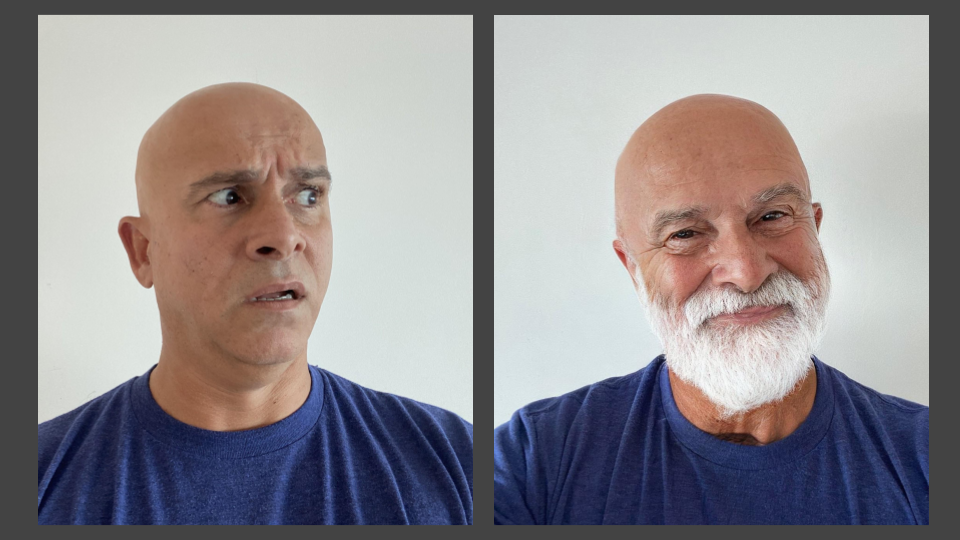
Two Marcelos appear next to each other, one looks much older, the yourger Marcelo looks at their older-self with a surpringly funny face.
Act quickly
You were not given much notice about this unexpected visit. You will have to act quickly and think of some questions to ask your future self.
What questions would you ask someone from the future?
Design Thinking Activity
The following activity is broken into two parts:
- Ice breaker - a fun way to connect participants with their older figures.
- The Interview - four simple steps to help participants generating, prioritizing and answering hypothetical questions, followed by a moment of self-reflection.
Part 1: Ice Breaker
Imagine you as an older person using the face editor application FaceApp.
- Audience - Anyone looking to reflect on human behavior over time
- Duration - 5-10 minutes
- Expected Outcome - A fun way to empathize with your future conditions.
- Preparation - Download the app from one of the following app stores:
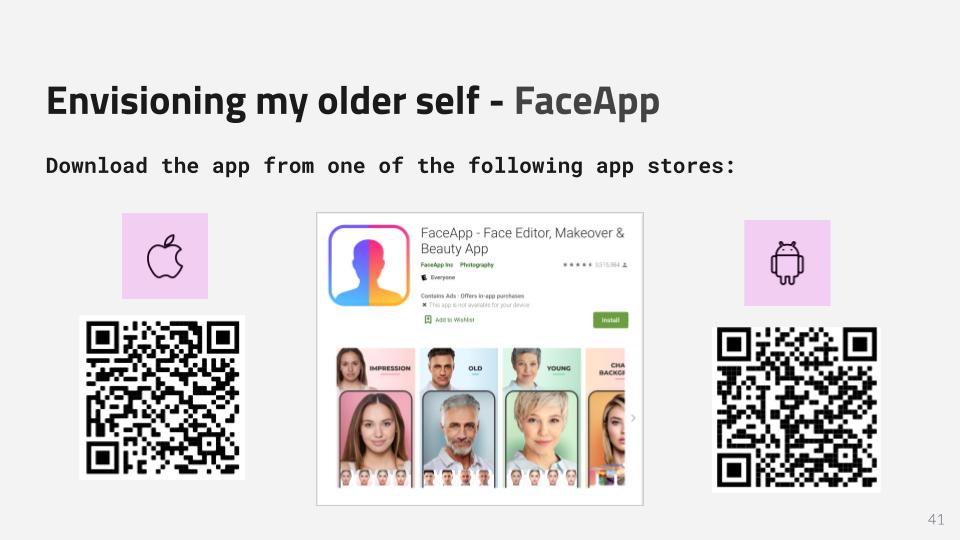
Download the FaceApp application by scanning one of the QR codes displayed on this image.
- Using the app - Download the app from one of the following app stores:
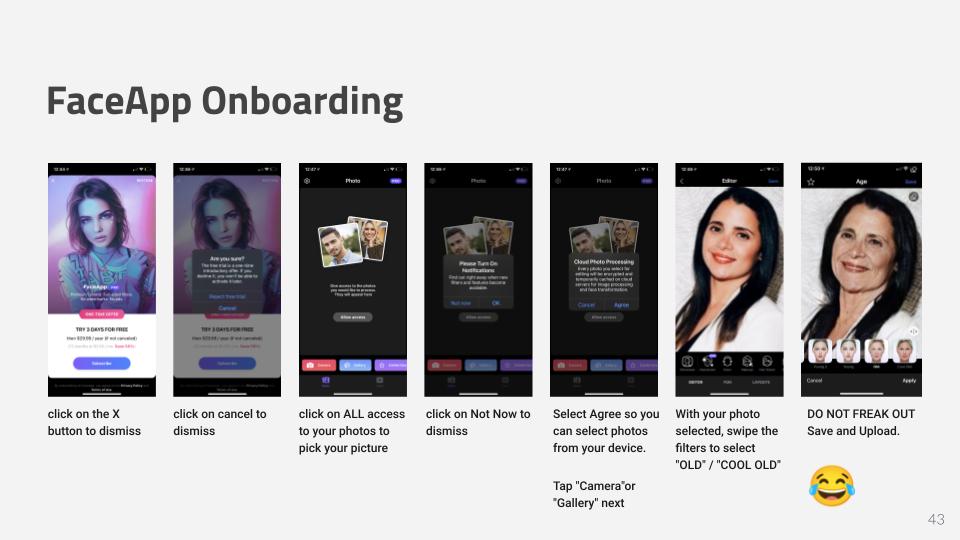
Step-by-step instructions on how to use the FaceApp. Credits to Laura Bries.
Part 2: The Interview
- Preparation - Download the worksheet and photos from the ice breaker activity
- Audience - Anyone looking to reflect on human behavior over time
- Duration - 5-10 minutes for each step
- Expected Outcome - An open discussion about our current behaviors impact others and how changes in society shape our moral and intellectual values
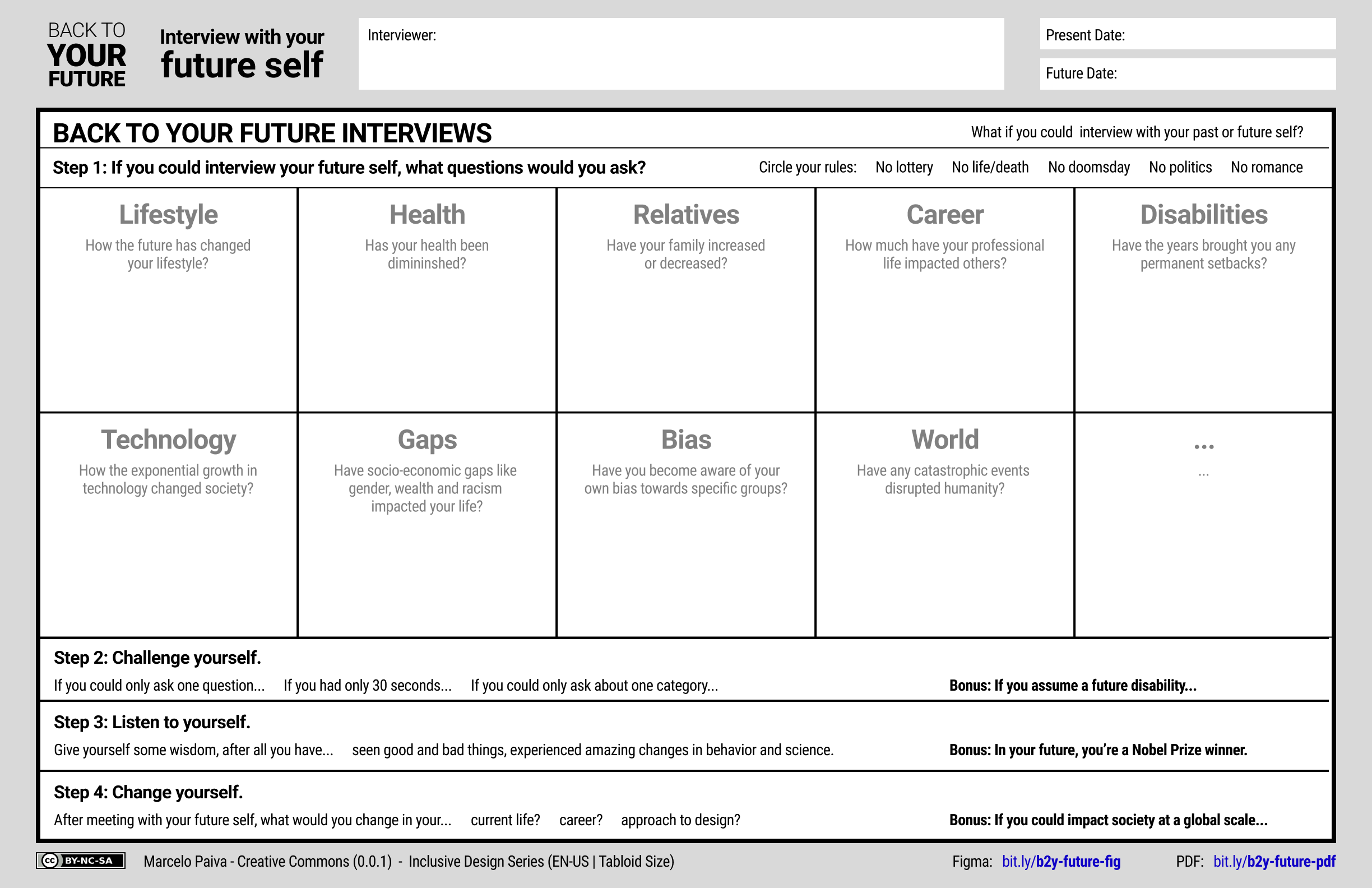
Worksheet created by Marcelo Paiva inviting designers to think about their future self and the disabilities they may acquire over the years.
Step 1: Create your questions
If you could interview your future self, as someone much wiser and experienced, that have survived some hardships in life, seen the good in society, as well as new technological inventions, and been treated by the most advanced progress in science… what questions would you ask?

Example for creating questions for each category.
Consider the following categories to help you brain sparking some questions:
- Living: How has the future changed your way of living?
- Health: Has your health been diminished?
- Relatives: Has your family circle increased or decreased?
- Professional: How much have your professional life impacted others?
- Disabilities: Have the years brought you any permanent setbacks?
- Technology: How the exponential growth in technology changed society?
- Society: Have socio-economic gaps like gender, wealth, and racism impacted your life or the World?
- Bias: Have you become aware of your own bias towards specific groups?
- World: Have any catastrophic events disrupted humanity?
Step 2: Challenge your questions.
This step will help you prioritize the most important questions with a twist.
What if:
- If you could only ask one question?
- If you had only 30 seconds?
- If you could only ask about one of the above categories?
Bonus:
- What if you assume a future disability?
Select the final questions to ask and get ready to meet your older self!
Step 3: Listen to your future self.
Grab those photos from the ice breaker, spend a few seconds looking at your older self and ask your questions.
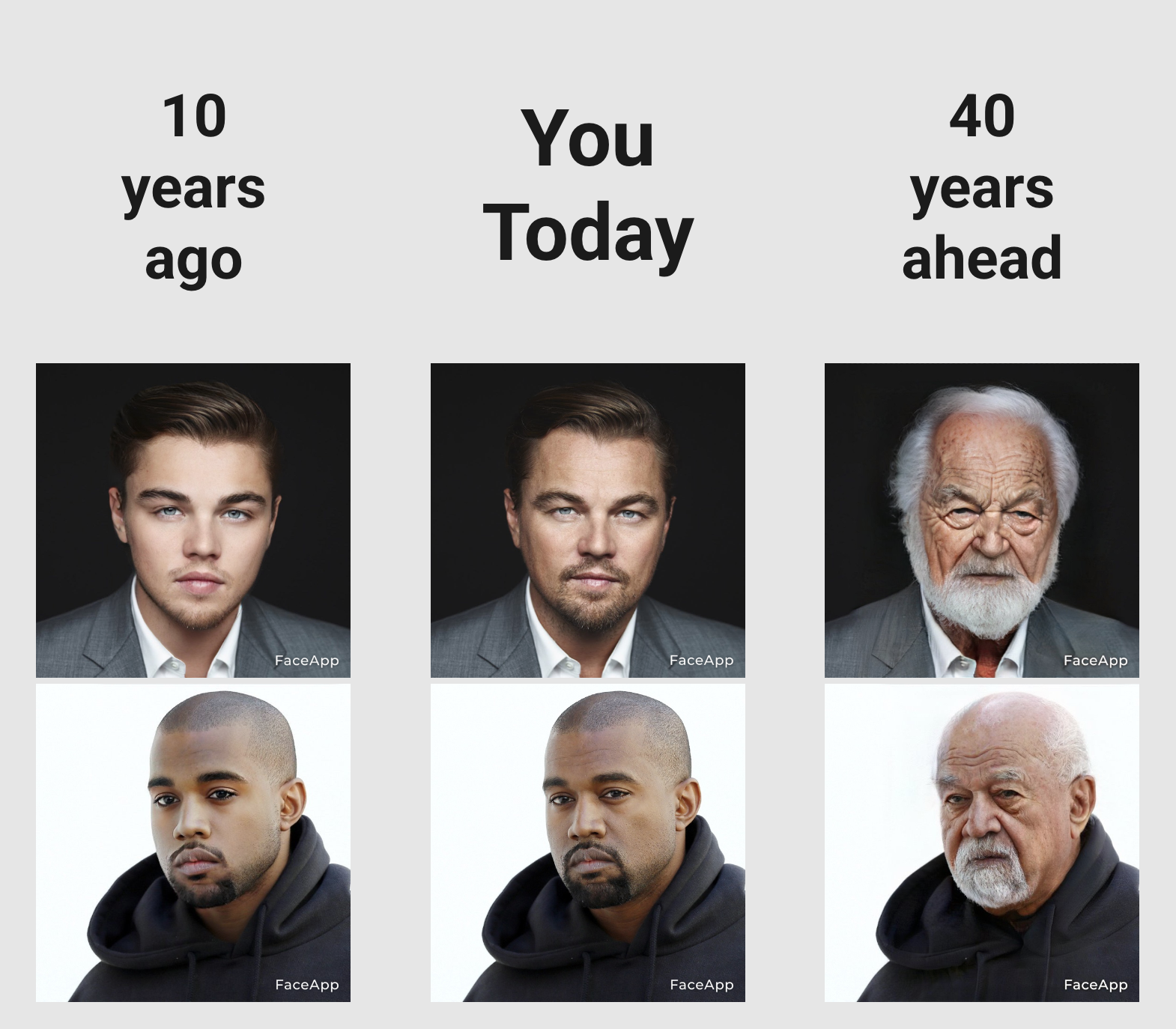
Example of the photos converted using the FaceApp. Leonardo DiCaprio and Kanye West and shown in three photos each. From left to right, they appear as young as 10 years ago, as they are Today, and as they would look like 40 years from now.
Step 4: Reflect on unnecessary behaviors.
Take a moment to reflect on the possible answers you may have received from your future self:
- What type of advice or wisdom may you have received?
- Was your future self a person who may have impacted the World?
- What type of disabilities your future may have acquired, and how did you overcome any barriers?
- What did this person have to say about the things we take for granted?
- Will you change the way you create solutions or work?
Once you have the chance to go around and listen to what others have to share, ask the group to create some goals to better their lives.
What are the small things you can change Today that will help your life in the future?
In my case, my future self told me:
Marcelo, you will have diabetes and severe hearing loss, but your faith will help others.
And gave some tips:
It is never too late to exercise, meditate, and learn American Sign Language.
Conclusion: Disabilities and Ageism
We all have opportunities to change our bias towards who we are Today. This exercise is for anyone who creates solutions for others and assumes things will never change in our own lives.
- 61 million adults in the United States live with a disability.
- 26 percent (one in 4) of adults in the United States have some type of disability.
Please consider how we behave towards the aging population or how we refer to older colleagues or family members.
Ageism is stereotyping and discrimination against individuals or groups based on their age.
We are all aging since the day we were born.
Please leave you comment and suggestions below. Contact me on linkedIn if you have any questions or need help bringing this workshop to your team or organization.
Tulane University’s Design Thinking Breakfast
The following deck was first presented in November 2020 at The Phyllis M. Taylor Center for Social Innovation and Design Thinking, as a guest speaker at Tulane University, as part of their Design Thinking Breakfast series.
Credits
Cover Photo by Glen Hodson on Unsplash
Next: Recognize Exclusion
Check out the essay I co-wrote for the UXPA Journal of Usability Studies and learn about the #1 principle for Inclusive Design principle: Recognize Exclusion.
